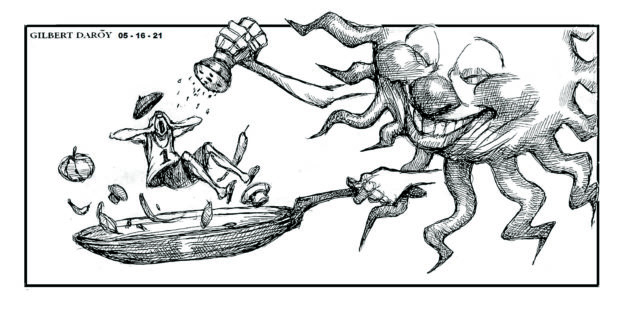
Editorial cartoon
On Tuesday, in San Jose del Monte, Bulacan, a driver suffered a heart attack while aboard his vehicle, causing the truck to barrel into a queue of people waiting to receive their ayuda from the city government. It was a double tragedy — the 57-year-old driver dead on arrival at the hospital and one in the impoverished crowd getting killed, while five others were injured. An initial police statement said the driver suffered from heatstroke, while later reports said it was a heart attack — which can be triggered by very high heat or extreme changes in temperature.
The blistering days have become dangerous as the country’s temperature continues to soar. The Philippine Atmospheric, Geophysical and Astronomical Services Administration (Pagasa) has advised the public to stay indoors and drink plenty of water. It forecasts no respite from the high temperature currently being experienced throughout the dry season or until this month due to easterlies and high sea temperature.
Just last Wednesday, May 12, Dagupan City in Pangasinan recorded a heat index — or the temperature people perceive or feel affecting their body—of 52°C. That figure is within the “danger” level, which ranges from 41°C to 54°C as classified by Pagasa. The other classifications fall under “caution” (27°C-32°C), “extreme caution” (32°C-41°C), and “extreme danger” (54°C and higher).
Pagasa said Dagupan’s air temperature was 37°C and relative humidity was 60 percent for that day, resulting in the heat index of 52°C. Then last Friday, Dagupan’s heat index broke that previous record by hitting 53°C, the highest so far this year. At least 13 other places mostly in Luzon also recorded heat indices that were within danger level, including Naia in Pasay City (41°C).
In its advisory, Pagasa noted that prolonged exposure and activity even during lower temperatures within the 27°C-32°C range can still cause fatigue, while continuing activity under soaring temperatures can result in heat cramps, or worse, heat stroke.
The infernal heat frying the country comes as cities and communities continue to stew under lockdown. The NCR Plus Bubble (Metro Manila, Bulacan, Cavite Laguna, and Rizal) is now under general community quarantine (GCQ) with “heightened restrictions” until end of the month. Public transport and the operation of commercial establishments such as restaurants and salons are allowed but still at very limited capacity, and subject to strict health protocols.
On the other hand, entertainment places like theaters and bars, and recreational venues like amusement parks, fairs, and playgrounds, remain suspended. This means a repeat of last week’s Gubat sa Ciudad incident should not happen again, even if the weather becomes unbearably hot and families look for ways to cool off.
The Gubat sa Ciudad fiasco saw about 300 people, whole families including minors and the elderly, descending on the resort on Mother’s Day to frolic in a common pool. It was no doubt a refreshing break for the revelers, but the occasion was exactly the kind of mass gathering where people end up lowering their guard—putting down their masks while swimming or eating, laughing and talking heartily, and forgetting proper physical distancing.
Later in the day, a TV cameraman sustained injuries after some in the crowd, angered at the resort management’s panicked decision to put an end to the revelry soon after photos surfaced on social media, ganged up on him and his crew for taking footage of the incident.
The Caloocan City government has filed criminal complaints against the management, and has called on the resort visitors to isolate themselves and get tested.
It’s understandable that a weary public would want to take a break from being locked up in their homes for over a year now. But COVID-19 remains a mortal danger out there, more so with new variants already reported in the country. This time, say experts, the quarantine has been a blessing in disguise, forcing people to stay indoors where they are protected from both the virus and the punishing heat outside.
Pagasa senior weather specialist Chris Perez said the recent heat indices the country has seen are “very alarming,” particularly for those who are vulnerable to heat strokes and exhaustion. His advice: “As much as possible, the public should avoid unnecessary outdoor activity. For those who have to be outdoors, they should take time to rest under the shade, drink water and bring umbrellas, which are both helpful against the heat and rains brought by localized thunderstorms.” Also, wear lightweight and light-colored clothing; and avoid liquor, coffee, tea, or sugary drinks, as well as food high in protein, because they can increase metabolic heat.